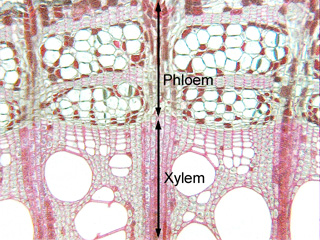 Fig.
8.1-5. Transverse section of mature stem of
grape (Vitis). Once plants become woody, they produce secondary phloem
(part of the bark) to the exterior of the secondary xylem (the wood) (this is
true of dicots and gymnosperms only -- monocots, with their easy-to-see phloem,
do not ever become woody the way that dicots and gymnosperms do). This
micrograph of secondary phloem in grape shows a rather unusual dicot phloem --
the sieve tube members are large and recognizable, and they occur in clusters
surrounded by phloem fibers. At this magnification it looks as if the companion
cells are also easy to see -- the small red cells, but unfortunately, those are
just tannin cells (notice there are some in the xylem too -- and companion cells
never occur in xylem). The real companion cells are very tiny and inconspicuous,
a few are just barely visible as flat green plates against the sides of some
sieve tube members.
Fig.
8.1-5. Transverse section of mature stem of
grape (Vitis). Once plants become woody, they produce secondary phloem
(part of the bark) to the exterior of the secondary xylem (the wood) (this is
true of dicots and gymnosperms only -- monocots, with their easy-to-see phloem,
do not ever become woody the way that dicots and gymnosperms do). This
micrograph of secondary phloem in grape shows a rather unusual dicot phloem --
the sieve tube members are large and recognizable, and they occur in clusters
surrounded by phloem fibers. At this magnification it looks as if the companion
cells are also easy to see -- the small red cells, but unfortunately, those are
just tannin cells (notice there are some in the xylem too -- and companion cells
never occur in xylem). The real companion cells are very tiny and inconspicuous,
a few are just barely visible as flat green plates against the sides of some
sieve tube members.